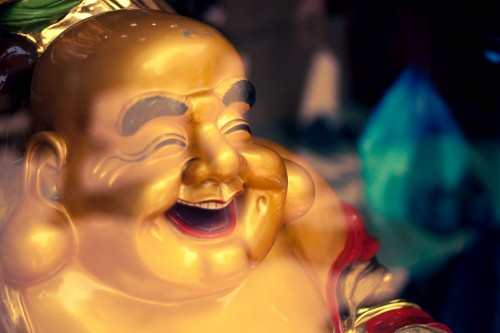
For this week of Brainwave 2016: Emotion, we’re focusing on humor and the array of effects of laughter on the mind and body. In honor of April Fools’ Day, we’ll break down what exactly humor is, why it may be good for you, and how to laugh more.
What is humor?
When explaining humor, experts largely cite the theory of “incongruity,” that humor is the result of the brain resolving an internal conflict about something that was not expressed explicitly. According to neuroscientist and Brainwave speaker Moran Cerf:
If you take a joke and look at its punch-line, you’ll often see that there’s a hidden statement there that your brain has to resolve on its own. For example, say someone asks me, “Why did the chicken cross the road?” The chicken actually wants to be on the other side of the street, but chickens don’t even know that humans call this black asphalt thing a “˜street.’ Chickens are thinking like humans here, but that’s impossible! The person that told the joke didn’t say, “Chickens are thinking like humans.” It was my brain that said that internally, and it’s uncomfortable (and maybe stupid) to think that—it wasn’t something that I was going to say out loud. So there’s this strange unresolved thing happening in my mind right now. That’s new. That’s funny. Let’s laugh it out!
Laughter is the Best Medicine
“Laughter is the sun that drives winter from the human face.” – Victor Hugo
Many studies have demonstrated that indulging in humor can have a variety of benefits on the mind and body. A recent study at Loma Linda University measured the memory recall and cortisol (the hormone responsible for stress) levels in those that watched funny videos versus those who remained silent. The humor group had a 40% recall rate and lower cortisol levels, compared to the silent group’s 23% recall rate and cortisol levels.
Similarly, another study found that a sense of humor may prevent heart disease. People with heart disease were found to be 40% less likely to laugh in certain situations as compared to those without heart disease. It seems as if the saying “laughter is the best medicine” rings true.
Tips for Embracing Humor
Find humor in your small mistakes and mishaps
Not all things in life are as serious as we build them up to be, so laugh about it instead! Try to find the irony in the situation at hand.
Prioritize spending time with people who make you laugh
Humor brings people together, connecting us via a shared, inside experience. Figure out your own sense of humor and find people who share it—whether it’s your friend, co-worker, or family member.

Play with animals or kids
Who is the giggliest, silliest of them all? Children, puppies and kittens! The average four-year-old child is rumored to laugh over 300 times each day. Adults are said to only laugh 15 to 20 times each day. Spend some time around a kid or play with a puppy, and you’ll find yourself laughing just as much.

Take confidence in the sound of your laugh
Maybe you do want to laugh a lot, but hold it back because you are self-conscious of the sound of it? Remember that everyone has their own kind of laughter! Find humor even in the sound of your own chuckle. Humor should be shared and uniting, not created at the expense of others.
Check out these funny resources:
If you’re not so great at making your own jokes and don’t know anyone with a kitten, flip the channel to a funny TV show or watch a comedy. Here is a list of TimeOut’s 100 best comedy movies. If you love The New Yorker cartoons, take a cue from cartoonist and Brainwave speaker Bob Mankoff and check out his favorite cartoons of 2015. And finally, have you ever wondered what the funniest joke in the world is? Psychologist Richard Wiseman ran an experiment to get to the bottom of that question. Here’s what he found.

Learn more about emotions and the brain at an upcoming Brainwave talk.


